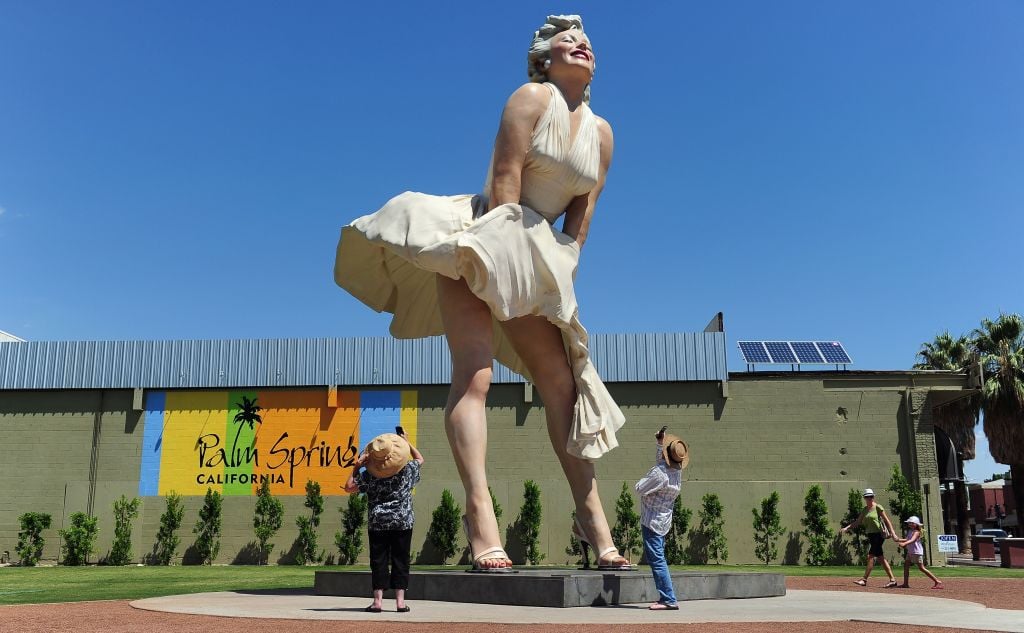
A 26-foot-tall sculpture of Marilyn Monroe playfully patting down her upblown skirt is the source of a heated debate in Palm Springs, California.
The town’s city council has approved the, um… cheeky statue—a recreation of the actor’s iconic scene atop a blustery subway grate from the 1955 Billy Wilder comedy The Seven Year Itch—to be installed near the Palm Springs Art Museum for a three-year period. But not everyone is pleased with the decision.
“You come out of the museum and the first thing you’re going to see is a 26-foot-tall Marilyn Monroe with her entire backside and underwear exposed,” the museum’s executive director and CEO Louis Grachos told council members last week, according to the Desert Sun. “We serve over 100,000 school-age children that come to our museum every single year. What message does that send to our young people, our visitors and community to present a statue that objectifies women, is sexually charged and disrespectful?”
Grachos did not immediately return Artnet News’s request for comment.
This will mark the second stint for the statue, called Forever Marilyn, in the Southern California town. Erected in 2011 by sculptor Seward Johnson, the towering artwork previously lived on the corner of a busy intersection two blocks from the museum between 2012 and 2014. Even then, the sculpture drew complaints from Palm Springs community members who saw it as overly sexual and déclassé.
Its new location on Palm Springs’s Museum Way would put it even closer to the institution. And for the museum, Gracho points out, being associated with the suggestive sculpture in today’s social justice-oriented society would not play well.
“Can you imagine when #MeToo gets a hold of this?” Grachos asked the council. “It’s not just going to hurt the museum, but it’s going to hurt our whole community.”
Sculptor Seward Johnson attends the unveiling of his statue Forever Marilyn on the occasion of a retrospective of his work at Grounds For Sculpture on May 2, 2014 in Hamilton Township, New Jersey. Photo: Bobby Bank/WireImage.
Steven H. Maloney, chair of the museum’s board of trustees, echoed the sentiment in a letter to the town’s mayor and city council.
“Displaying the statue in front or near the museum implies institutional approval and an unhealthy encouragement of risqué behavior of women,” Maloney wrote. “It also fundamentally misconstrues the role of cultural institutions, which is to facilitate a diverse public’s engagement with a rich array of culture and art.”
Still, in its first stint last decade, others found Forever Marilyn charming. P.S. Resorts, a consortium of hotels geared toward boosting tourism, has been working since 2014 to bring it back. Last year, it was announced that, in conjunction with the town’s tourism officials, the group had succeeded in securing the artwork for permanent display.
“Marilyn has become somewhat of an icon for Palm Springs and some love her and some not so much, but at the end of the day she’s become part of our brand,” councilman J.R. Roberts said at the time.
Since then, the city council has walked back its commitment a bit, agreeing to host the statue for what amounts to a trial period of three years. P.S. Resorts had previously offered to buy the sculpture outright for $1 million, but now the group is looking at leasing options.
Johnson, who passed away in March of this year at age 89, was known for his figurative bronze sculptures, many of which recreated famous art historical scenes. Among the artist’s creations were large-scale statues depicting Matisse’s Dance figures and the staid couple from Grant Wood’s American Gothic.